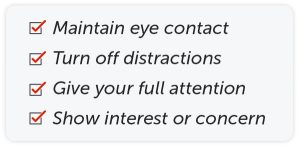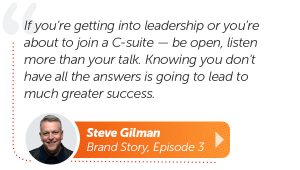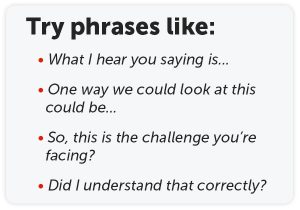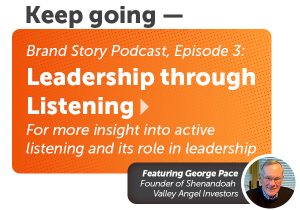Table of Contents
When was the last time you gave a customer or client your undivided attention?
One of our most crucial professional skills is effective listening, and yet it seems like so many people don’t know how to listen anymore. Maybe it’s a symptom of our social media-obsessed world. Or, maybe many of us never really learned how to actively listen in the first place. I’ve always believed that an important skill for a business person to master is the skill of active listening.
While it’s not simple to become an active listener and it won’t happen overnight, there are steps you can take immediately that will help you to improve your communication skills. I’ve included some below, but remember, active listening is a commitment, not a parlor trick. You must have the honest desire to both hear and understand the people whom you serve. First, it’s important to know what kind of listeners are out there.
Active Listening vs Passive Listening vs Selective Listening
Understanding the difference between active, passive, and selective listening can help you understand how to become a better listener.

Active listening involves being present during an entire conversation. An active listener isn’t thinking about anything but the speaker’s words, and they make that clear through verbal and nonverbal communication. After the speaker is finished talking, the listener will ask open-ended questions and ensure they understand what the speaker is saying.

Passive listening is hearing, but not focusing on what the speaker is saying. When someone is passively listening, they might be thinking about a different topic or what they’re going to say next. After this conversation, the listener may not entirely understand or remember what was discussed.

Selective listening occurs when someone is only listening when they want to. The listener may look alert and ask questions when the topic pertains to them, but zone out when they are no longer interested.
You may realize that you aren’t always an active listener, and that’s okay. With practice of the tips below, you’ll be ready to give each conversation the attention it deserves.
1. Maintain your focus

Make and maintain eye contact. Remove distractions, turn off computer monitors or your cell phone, and do not read text messages or emails. Giving another person your full attention sends a powerful message. Use language that shows your interest and concern, try phrases such as “I’ve been thinking about what we talked about yesterday,” or “I think the point you had was interesting because…”
2. Commit to stop talking

Many people are so focused on what they’re about to say that they completely miss what a colleague, client, or customer is trying to communicate. So do your best to pay attention, quiet your mind, open your ears, and try to truly listen to what the other person is saying. Good listening requires the ability to put your agenda aside and focus on meeting the needs of your customer. If you find yourself having a hard time focusing, try reciting what the speaker is saying in your head to prevent other thoughts from intruding.
3. Become a positive mirror

Practice rephrasing or restating. Try this phrase, “What I hear you saying is,” then reflect back a brief summary of what you’ve heard. Frame or reframe to build perspective. “I see some key themes here,” or, “One way we could look at this could be…” Reframing requires you to use critical thinking and creative insights to take small positive emotional leaps.
Asking a question can also show that you’re listening and clarify any information. Asking, “So, this is the challenge you’re facing?” or “Did I understand that correctly?” can reassure someone that you’re dedicated to helping them find solutions.
4. Walk in their shoes
Practice empathy while you listen by putting yourself in the place of the other person. Imagine how they might be feeling about their experience, their colleagues, and the topic of conversation. Frequently remind yourself to examine the situation from your customer or client’s perspective, and to withhold any judgment. Try phrases like “That must have been frustrating for you because…” or “I imagine you just wanted to…”
5. Listen to the body
Nonverbal cues are all around us. There is a great deal of valuable information in facial expressions, body language, and other unconscious behaviors. It’s a big subject that goes far beyond the folded arms stereotype and there is way too much to cover effectively in this post. For a good resource on nonverbal communication, I recommend the book “Louder Than Words” by Joe Navarro.
Building Stronger Relationships
Whether you’re a business leader, work in customer service, or are just trying to be a good friend, showing that you’re present in a conversation will strengthen the trust in any relationship. When you are actively listening, you show the other person that you care about what they’re saying. With nonverbal cues, like eye contact and posture, and verbal signs, such as rephrasing or restating, you can transform the possibilities of every conversation.
Try these five tips and be patient with your progress. Active listening can be challenging but one thing is for sure — improving your listening skills will have a positive effect on every business relationship you have.

